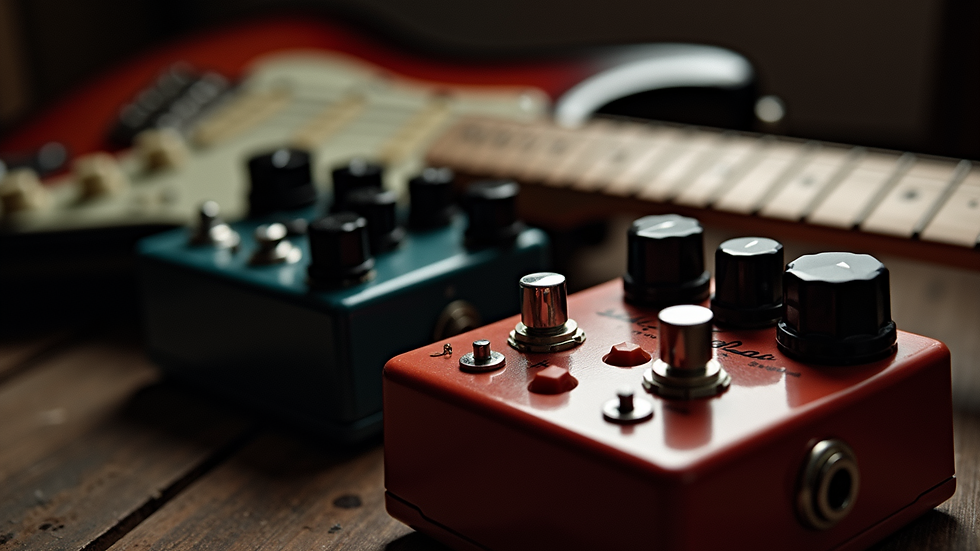Getting Started with Electric Guitar Lessons
- Simon

- Sep 18, 2025
- 4 min read
Picking up the electric guitar for the first time is an exciting adventure. Whether you’ve always dreamed of shredding solos or just want to strum along to your favourite tunes, starting out can feel a bit overwhelming. But don’t worry - I’m here to guide you through the basics, share some tips, and help you find your rhythm. By the end of this post, you’ll feel ready to dive into the world of electric guitar with confidence and a smile.

Why Choose Electric Guitar for Beginners?
Electric guitars are incredibly versatile instruments. They can produce a wide range of sounds, from smooth jazz tones to heavy rock riffs. For beginners, this means you can explore different styles and find what suits you best. Plus, electric guitars are generally easier to play than acoustic guitars because their strings are lighter and the necks are slimmer.
One of the best things about starting with an electric guitar is the ability to plug into an amplifier and experiment with effects. This opens up a whole new world of creativity. Imagine adding a bit of distortion for a gritty rock sound or a touch of reverb for a dreamy vibe. It’s like having a musical playground at your fingertips.
If you’re wondering where to start, consider looking for a beginner-friendly electric guitar that feels comfortable in your hands. Brands like Squier, Yamaha, and Epiphone offer great options that won’t break the bank. Remember, the right guitar is the one you enjoy playing the most.
Finding the Right Electric Guitar for Beginners
Choosing your first electric guitar can feel like a big decision, but it doesn’t have to be stressful. Here are some key points to keep in mind:
Body style: Electric guitars come in various shapes and sizes. Some are solid-bodied, while others have semi-hollow or hollow bodies. Solid bodies are great for beginners because they’re durable and versatile.
Neck profile: The thickness and shape of the neck affect how comfortable the guitar feels. If you have smaller hands, look for a guitar with a slim neck.
Pickups: These are the magnets that capture the string vibrations and turn them into sound. Single-coil pickups offer a bright, clear tone, while humbuckers provide a thicker, warmer sound.
Budget: You don’t need to spend a fortune to get a good beginner guitar. Set a budget and try out a few models within that range.
Visiting a local music store to try different guitars can be really helpful. Don’t hesitate to ask the staff for advice - they’re usually happy to help you find the perfect fit.

How much is an electric guitar lesson?
One of the most common questions when starting out is, “How much is an electric guitar lesson?” The answer varies depending on where you take lessons and who your teacher is. Private lessons with experienced instructors can range from £20 to £50 per hour. Group lessons or online courses might be more affordable, sometimes costing as little as £10 per session.
If you’re looking for flexibility and personalised guidance, online platforms like Tremolo Guitar School offer excellent options. They provide tailored lessons that fit your schedule and skill level, often at a fraction of the cost of traditional lessons.
Remember, investing in lessons is investing in your progress. Regular practice combined with good instruction will help you improve faster and keep your motivation high.
Getting the Most Out of Your Electric Guitar Lessons
Once you’ve started your lessons, it’s important to make the most of them. Here are some tips to help you stay on track and enjoy the learning process:
Set clear goals: Whether it’s learning a favourite song or mastering a particular technique, having goals keeps you focused.
Practice regularly: Even 15-20 minutes a day can make a big difference. Consistency beats long, infrequent sessions.
Record yourself: Listening back to your playing helps you spot areas for improvement.
Ask questions: Don’t be shy about seeking clarification or extra help from your teacher.
Have fun: Remember why you started playing in the first place. Enjoy the journey!
It’s also helpful to supplement your lessons with additional resources like tutorial videos, backing tracks, and guitar tabs. The more you immerse yourself in music, the quicker you’ll grow.

Your Next Steps on the Electric Guitar Journey
Starting with the electric guitar is just the beginning of a lifelong musical adventure. As you build your skills, you’ll discover new styles, techniques, and maybe even write your own songs. Keep exploring different genres, from blues and rock to funk and metal. Each style will teach you something new and keep your playing fresh.
If you’re ready to take the plunge, consider signing up for electric guitar lessons that suit your pace and interests. With the right guidance and a bit of patience, you’ll be amazed at how far you can go.
So, grab your guitar, tune up, and let the music begin!




Comments